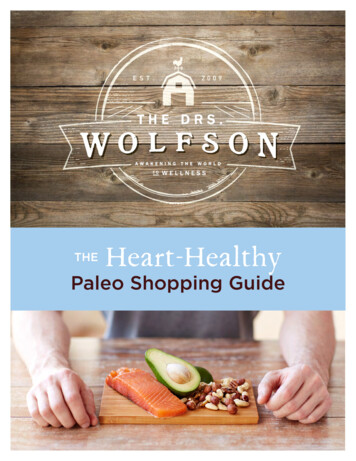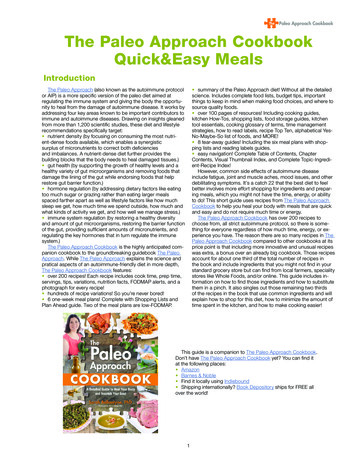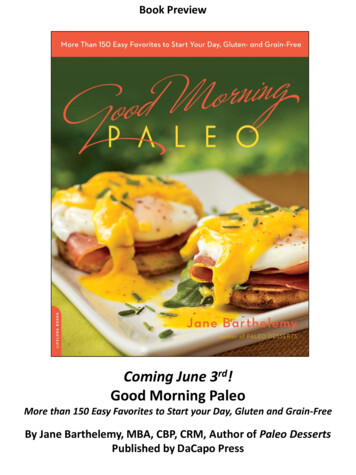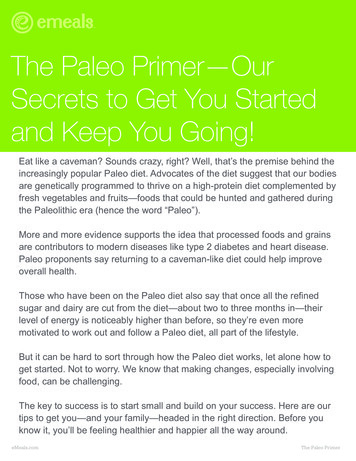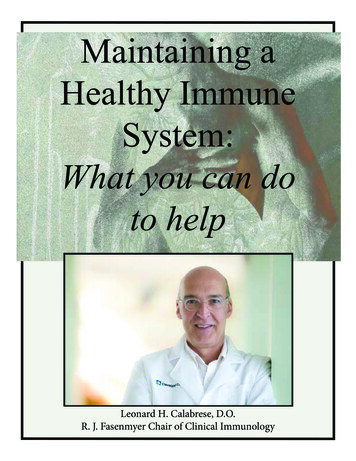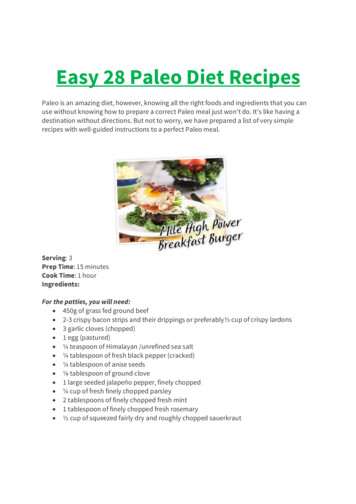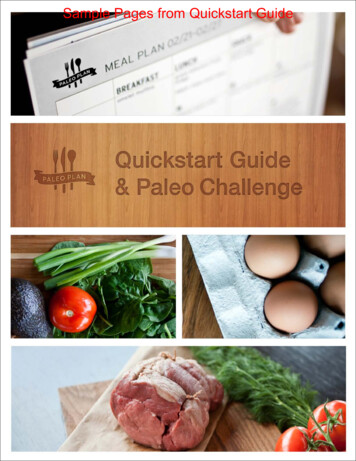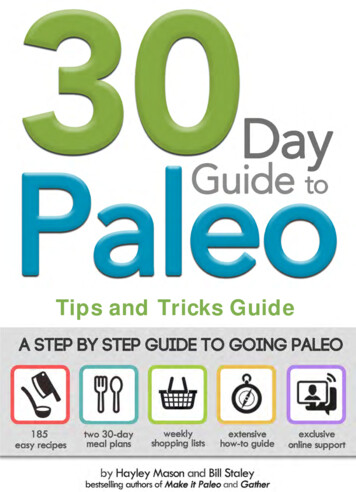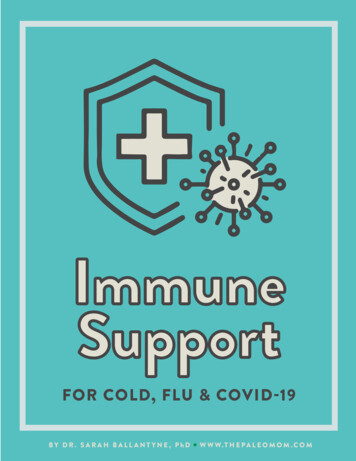
Transcription
ImmuneSupportFOR COLD, FLU & COVID-191IMMUNEB Y DSUPPORTR . S A R AbyH Dr.B ASarahL L ABallantyne,N T Y N EPhD, PhDW W W.T H E PA L E O M O M . C O M
IMMUNESUPPORTFOR COLD & FLUBY DR. SARAH BALL ANT YNE, PhD Copyright 2020 the Paleo Mom LLCNo part of this publication may be reproduced, distributed, or sold in whole or in part, by any means,with or without financial gain, without the prior written consent of the author. The informationcontained in this book is for educational purposes only.DisclaimerAlways consult your healthcare provider before making any diet or lifestyle changes. The recommendations in this book are not intended to diagnose, treat, cure, or prevent any disease. By reading thisbook, you agree that The Paleo Mom LLC is not responsible for your health relating to any informationpresented in this book. This book contains affiliate links to products or services on external websites.This means that The Paleo Mom LLC receives a small commission when purchases are made at thesesites without any increased cost to the buyer.2IMMUNE SUPPORT by Dr. Sarah Ballantyne, PhD
TA B L E of C O N T E N T SABOUT THE AUTHOR .4SPECIAL REPORT: COVID 1.5REDUCING EXPOSURE.7Why Social Distancing is Needed.8PRIORITIES FOR IMMUNE SUPPORT.10Get Enough Sleep .10Manage Stress.16Get Moderate-Intensity Exercise.21NUTRIENTS FOR IMMUNE SUPPORT.237 Tips to Eat More Veggies.26Top Food Sources of Essential Nutrients.27WHAT ABOUT SUPPLEMENTS?.28WE’RE IN THIS TOGETHER.31Additional Reading.33RECOMMENDED RESOURCES.34References .363IMMUNE SUPPORT by Dr. Sarah Ballantyne, PhD
ABOUT THE AUTHORDr. Sarah Ballantyne, PhDAward-winning public speaker, New York Times bestsellingauthor and world-renowned health expert, Dr. SarahBallantyne, PhD (aka The Paleo Mom) believes the key toreversing the current epidemics of chronic disease is scientificliteracy. She creates educational resources to help peopleregain their health through diet and lifestyle choices informedby the most current evidenced-based scientific research.Dr. Sarah earned her doctorate degree in medical biophysics atthe age of 26 and spent the next four years doing research oncritical care medicine, innate immunity, gene therapy and cellbiology, earning a variety of awards for research excellencealong the way.Sarah’s transition from academic researcher to stay-at-home mom to award-winning andinternationally-recognized health advocate and educator was driven by her own health journey,which included losing 120 pounds and using both diet and lifestyle to mitigate and reverse a dozendiagnosed health conditions. Sarah’s talent for distilling scientific concepts into straight-forwardand accessible explanations form the foundation of her work and her dedication to improvingpublic health.Learn more by checking out Sarah’s website, podcast and books. You can also find Dr. Sarahon Instagram ,Facebook, Pinterest and Twitter or join her private Facebook Community here.4IMMUNE SUPPORT by Dr. Sarah Ballantyne, PhD
SPECIAL REPORTCovid-19As fears over covid-19 mount during the already-underway cold and flu season, I feel that it’s important to highlight the positive actions we can each take to naturally support our immune systems. Letme emphasize right out of the gate: These are diet and lifestyle strategies that support immune healthand have been shown in scientific studies to reduce susceptibility to infection. These strategies are nota substitute for medical care and if you suspect that you may have covid-19 (or the flu for that matter),it’s incredibly important to call your doctor, and follow their up-to-date advise on testing, isolation andmitigation.The symptoms of covid-19 include fever (present in 83% to 98% of patients), cough(present in 46% to 82% of patients), shortness of breath (present in about 31% ofpatients), fatigue or muscle aches (present in 11% to 44% of patients), with less commonsymptoms such as headache, loss of taste or smell, sore throat, abdominal pain anddiarrhea also reported.Covid-19 is the name of the disease caused by the novel coronavirus, which has been named SARS-CoV-2by the International Committee on Taxonomy of Viruses (its predecessor SARS-CoV was responsible forthe 2002 SARS outbreak).Current estimates are that at least 80% of people infected have a “mild” disease course, encompassing everything from asymptomatic to walking pneumonia(in this case, a mild course is delineated as those whodo not require hospitalization), whereas 20% havea moderate to severe disease course, including viralpneumonia requiring hospitalization and respirationsupport (such as supplemental oxygen or mechanicalventilation). Analysis of data released by the ChineseCenter for Disease Control shows a case fatality rateof 2.3%, but this may be an overestimation due tounder-counting of mild cases. As of 3-27-2020, themortality rate in South Korea, which has done themost wide spread testing of any country so far (they5IMMUNE SUPPORT by Dr. Sarah Ballantyne, PhD
are testing about 10,000 people per day and even have drive-thru test facilities!), is about 1.5%. That’sstill nearly 15 times higher than the seasonal flu so far this year. Vulnerable populations include olderadults (especially over 65 years old), smokers, and people with pre-existing conditions, including diabetes, high blood pressure, and cardiovascular disease.One reason to be concerned about covid-19 is that it appears to be highly contagious.It is spread primarily via respiratory transmission (there is some data showing othermodes of transmission such as fecal transmission are also possible) and the incubationperiod averages 5 or 6 days, but may range anywhere for 1 to 14 (with one study suggesting the incubation period could even be as high as 24 days).The reproductive number (R0 [pronounced “arr not”], the expected number of secondary cases producedby a single infected person in a susceptible population, is between 2 and 3, which means that, whilecovid-19 is not a super-hot spreading virus (one that is spread by one patient to many others; forexample the R0 of measles in unvaccinated populations is about 18), it’s also clear that covid-19 won’tbe self-limiting (this pandemic won’t go away without us taking substantial action). And, there’s newevidence that people infected with SARS-CoV-2 may be contagious for up to several days prior to showing symptoms. It’s tough to extrapolate what percent of the total population could be affected if currentattempts to contain the spread of covid-19 are unsuccessful. While Harvard epidemiology professorMarc Lipsitch has been quoted as predicting 40-70% of the global population will get it, this type ofinfection rate has not yet been seen in any affected community, perhaps reflecting some success fromcontainment efforts. For example, the infection rate on the Diamond Princess cruise ship was about 19%(despite quarantine protocols) and the currently reported infection rate in South Korea is about 4% (91%of the people they’ve tested so far have tested negative, and the remaining 5% are waiting for their teststo be processed) To compare, between 3 and 15% of Americans get the seasonal flu each year. Unfortunately, it is possible that in the absence of adequate action, Professor Lipsitch’s estimates could bare out.While the situation remains incredibly dynamic and there remain many unknowns about covid-19, thereare some actions we can all take now to both reduce our potential exposure and support our immunesystems.6IMMUNE SUPPORT by Dr. Sarah Ballantyne, PhD
First and foremost, you can reduce your exposure bywashing your hands frequently and lathering up for a full20 seconds, making sure to get between fingers and undernails.A 2016 study looking at the effectiveness ofhand-washing on influenza infection showedthat proper hand-washing with soap and waterat prudent times (like before eating, afterusing toilet, and after returning home fromcommunity activities) reduced the chancesof getting the flu from 26% to 3%.Remember that the key here is to lather vigorously,which is far more important than what type of soap youuse. In the absence of soap and water, you may opt for a alcohol-based hand sanitizer that is at least 60%alcohol, making sure to use enough for it to take at least 15 seconds to evaporate, again rubbing yourhands together vigorously. When washing your hands is an option, that is preferable to hand sanitizer asit is more effective.Also, avoid touching your eyes and mouth, especially while you’re out and about (or anytime you haveunwashed hands); and, practice “social distancing”, meaning avoiding shaking hands, fist bumps, huggingetc. In general, try to maintain a 6-foot distance between yourself and anyone else when you’re out ofthe house. Clean surfaces in your home, especially high-touch areas like door nobs, drawer pulls, lightswitches, faucets, and countertops. And, clean your mobile phone daily.It’s also important to avoid crowded areas, especially where airflow may be limited or recycled, whichis why so many events have been cancelled and various state governments are enforcing limits on howmany people can gather. If you do feel even a little under the weather, or think that you may have beenexposed, do everyone a favor by staying home and practicing self care to get better as efficiently aspossible (even if you have a mild case because this helps protect more vulnerable people). And, if youhave the ability to stay home and self-isolate, even if you’re healthy and haven’t been exposed, that is atremendous contribution to current efforts to limit the spread of this virus. This is definitely a time tore-evaluate priorities and do everything we can as individuals not just to protect ourselves, but also ourcommunities.7IMMUNE SUPPORT by Dr. Sarah Ballantyne, PhD
WHY SOCIAL DISTANCINGIS NEEDEDBecause approximately 20% of those infected require hospitalization, and 5% require advanced respiratory support such as ventillators, the goal is to slow (or better yet, stop) the spread of covid-19 to bluntthe peak infection rate so that our medical systems won’t be overloaded with patients requiring respiratory support and/or ventilators all at once (as they are in Italy, where they’re even having to make wartime type decisions about who will receive treatment). The time that an effective coronavirus shutdowncan buy us may also allow for the development and testing of effective antiviral treatments, and fortesting capacity to ramp up sufficiently to meet current demand.The challenge is that, in the absence of widespread testing, we have so little informationto act on. An individual doesn’t know if they have a regular ol’ cold, a bad flu, or a mildcase of covid-19, so they don’t know whether or not to quarantine themselves. Worse,because there’s evidence that people can shed virus for up to 5 days before they showsymptoms, an individual could be spreading the novel coronavirus without even knowingthey were exposed.There’s even evidence that infected young people especially may be asymptomatic, meaning they canhave covid-19 and be contagious but with zero symptoms. Testing capacity has yet to ramp up to thepoint where people without symptoms or with only mild symptoms can qualify for testing. What thismeans is that social distancing and physical isolation are the only tools we currently have as a community to stop the spread of covid-19 and protect the vulnerable among us.We can observe what’s happening in other countries. Italy,for example, has been on lockdown for weeks already inorder to slow the spread of covid-19 to hopefully ease theoverwhelm of their medical system; people are asked notto leave their homes except if absolutely necessary and theonly businesses allowed to be open are pharmacies andgrocery stores. Most European countries have followedsuit. China mandated the largest quarantine in humanhistory, and is finally seeing a big drop-off in new cases.What’s the difference between a shutdown and a lockdown?In this context, a lockdown refers to a government mandated closing of schools, businesses, and social gatherings, inaddition to home isolation. In Italy, people who violate thelockdown rules potentially face several months in jail and
hefty fines. In contrast, a shutdown is a recommendation, which relies on businesses and citizens to takeprudent action, perhaps with a few mandates such as how many states have already banned gatheringsover a certain threshold number of peoples (CDC guidelines are to avoid social gatherings of more than10 people). It is my hope that if we come together in our communities to effectively shutdown for a fewweeks, we can prevent our situation from having to reach the extremes experienced in other countries.If you have the ability to just stay home, I strongly encourage you to do so. This choice isn’t just aboutprotecting you and your family, but protecting those in your community who are at high-risk of a severeor critical disease course. If you think youcan’t cloister yourself in your home for thenext weeks or months, I urge you to critically re-evaluate whether or not that’s actually true. I’m acutely aware that many peopledon’t accrue sick leave, are contract or gigeconomy workers that only get paid for thehours they put in, and/or are livingpaycheck-to-paycheck. Or maybe, you’vebeen labeled an essential worker, providinga necessary service to your community. Ifyou’re stuck between a rock and hard placeon this one, I don’t want to add to youranxiety or guilt. Instead, carefully read theinformation in this guide and institute everyaction item to protect yourself and thosearound you as best you can.9IMMUNE SUPPORT by Dr. Sarah Ballantyne, PhD
This will probably come as no surprise the most important things that you can do to support yourimmune system so that it can effectively beat an infectious disease are the same things that supportyour overall health: get enough sleep, manage stress, and live an active lifestyle while avoidingovertraining. These are also the healthy lifestyle choices that are the easiest to let slide when lifegets busy.So, a positive way to channel anxieties about covid-19 or influenza (or the next nerve-racking potentialpandemic) is as motivation to finally address lifestyle factors that might not be as dialed in as theycould be. And, any effort to implement a healthy lifestyle is likely to pay off, as we can see fromscientific studies looking at how sleep, stress and activity affect our susceptibility to colds, the flu,and pneumonia.GET ENOUGH SLEEPIn my popular online program, Go to Bed, I discuss all the many ways that sleep impacts our health –and the immune system is a major mechanism behind all of them!Just plain old “not getting enough sleep” causes inflammation. Even just threeconsecutive nights of inadequate sleep can cause measurable increases in markersof inflammation in the blood, straining our immune system so it’s less able torespond to a pathogen.Our immune system cycles with our circadian rhythm, along with antibody formation (the way ourbodies know to respond to super-specific invaders, like influenza or SARS-CoV-2), which predominantlytakes place during sleep. So, someone who is not getting enough sleep is also not adequately formingantibodies. As a result, simply getting adequate sleep can protect you from infection. Studies examiningdifferences or changes in sleep quality have found similar differences in immune function; basically,sleep quality and quantity is essential if we’re trying to protect ourselves from the flu season!Some studies have specifically looked at how our regular sleep patterns impact our susceptibility toinfection. A 2015 study in 164 healthy people, looked at how sleep impacted their risk of infection andclinical symptoms after being exposed to the common cold-causing rhinovirus (the researchers literally administered active rhinovirus up the participants noses!). After correcting for all other potentialcontributors, sleep duration was the biggest predictor of whether or not the people would get a cold(not sleep fragmentation or sleep efficiency). Sleeping less than 5 hours per night increased chances of10IMMUNE SUPPORT by Dr. Sarah Ballantyne, PhD
developing a cold by 4.5X compared to 7 or more hours of sleep!Yikes! And getting 5 to 6 hours per night wasn’t much better;the risk was still 4.24X higher than people who got 7 or morehours sleep. And getting 6 to 7 hours of sleep per night stillincreased risk of getting the cold by 66% compared to 7 or morehours. Similarly, a 2012 prospective study in female nurses aged37-57 with no pre-existing conditions showed those who routinely slept less than 5 hours per night had a 70% higher risk ofgetting pneumonia over the 4-year study period than those whoroutinely slept 8 hours per night.The single best thing most of us can do to make sure we’re getting enough sleep (8 hours really is a good rule of thumb) is havea grown-up bedtime and stick to it. I suggest a bedtime that is8.5 to 9 hours before your alarm goes off in the morning, whichallows for the normal 30ish minutes to fall asleep and normal arousals during the night. If the notionof prioritizing sleep is totally overwhelming, my e-book Go to Bed is loaded with tips and tricks (thatinclude everything from tiny tweaks to lifestyle overhauls!).Total Sleep Time Goal11IMMUNE SUPPORT by Dr. Sarah Ballantyne, PhD
5 WAYS TO IMPROVEYOUR SLEEP1. Get bright (blue) light exposure during the day.The light-dark cycle is the most important signal to our circadian clock. This means that one of the bestways to set your circadian clock is be exposed to bright light (ideally sunlight) during the day, but be inthe dark at night. In fact, sunlight exposure during the day is probably the single most important thingwe can do to support the normal production of melatonin in the evening. The component of sunlight thattells your circadian clock that it’s daytime is blue light. You have photoreceptors in your eyes and skinthat are sensitive to blue light (the receptors in your eyes are much more sensitive than those in yourskin) and convey that signal to the brain. How much time outside is enough? If it’s a sunny day, as littleas 15 minutes (without sunglasses!). If it’s cloudy, 30 minutes to an hour is better. And of course, the morethe better. So what do you do if you’re a shift worker or live in an ill-suited climate or have other barriers to being outside? There’s a great biohack available for getting blue light exposure during the day: alight therapy box. There doesn’t seem to be a difference between white light boxes and blue light boxesin terms of supporting melatonin production, so you can pick the least expensive option–but choose onethat is bright, at least 10,000 lux. Use it for at least 15 minutes at roughly the same time every morningor midday. Another option is to make many small changes to brighten your environment during the day:Circadian Rhythm12IMMUNE SUPPORT by Dr. Sarah Ballantyne, PhD
use sunlight spectrumlight bulbs in your house (but you’ll want to avoid using these light bulbs in theevening), keep curtains open during the day, make sure your computer monitor and other screens are setto its brightest setting, drive with the windows down . . . all these things help, but they still aren’t typically as bright as a light therapy box or just being outside, even on a cloudy day.2. Avoid bright (and blue) light in the evening.Just as it’s important for your body to get the signal that it’s daytime during the day (or your day, ifyou’re a shift worker and using a light therapy box), it’s important to tell your body it’s nighttime oncethe sun goes down. This means avoiding blue light and sticking with red and yellow wavelengths of lightas well as keeping the overall light level much dimmer. You can achieve this important “darkness signal”to your circadian clock by keeping your indoor lighting as dim as possible in the evenings with dimmerswitches, or just plain ol’ turning on fewer lights, in conjunction with investing in red or yellow lightbulbs for whatever lamps will be used in the evening. If you plan to use a computer monitor or watch TV,there are two options. The first is to install f.lux on your computer or Android devices, or use the NightShift feature on Apple devices, and then set the screen brightness to the lowest setting. The second, andprobably the best biohack for supporting evening melatonin production (more technically called dimlight melatonin production), is to wear amber-tinted glasses for the last 2 to 3 hours of your day. In fact,several scientific studies show that wearing amber-tinted glasses in the evening improves sleep qualityand supports melatonin production. What are amber tinted glasses? Quite simple: glasses with yellowlenses. These could be driving glasses, glaucoma glasses, or safety glasses (my personal preference is forthe larger lenses of safety glasses because they also block peripheral light and there are options that fitwell over regular glasses . . .plus they’re super cheap!). Amber-tinted glasses are also a great option forshift workers. A more sophisticated option for getting both your bright blue light in the day and yourdim red light in the evening is programmable light bulbs where you can set the color spectrum and thebrightness for the time of day (and you can program them to automatically change at whatever time youwant! how cool is that!). It’s an investment, but then you can ditch the goofy safety glasses (although,you’ll want to pull3. Reduce and manage stress.You probably recognize cortisol as being the master stress hormone. It’s also a very important circadian rhythm hormone. This means if you’re under stress, not only do you have all the effects of elevatedand dysregulated cortisol to deal with, but you also disrupt your circadian rhythms. Reducing stressmeans removing stressors from your life. Whether it’s saying no, asking for help, or making changes tothe structure of your life, whatever you can do to reduce stress will make a difference. Oh, and coffeeincreases your body’s response to psychological stressors, so you might want to cut down on coffee orgive it up altogether. Managing stress also means increasing activities that help regulate cortisol andmake you more resilient to stressors. This might include meditating, doing yoga, going for a walk, takinga bath, or making time for a hobby.13IMMUNE SUPPORT by Dr. Sarah Ballantyne, PhD
Just like being stressed can affect circadian rhythms, so can ignoring them. Your melatonin starts increasing about 2 hours before bedtime to prepare your body for sleep. If you’re muscling through thatwith a sugary snack, a scary movie, or whatever else you do to keep yourself awake at night, you areaffecting your circadian rhythms. It’s important to have a consistent bedtime and wake time. Allowing fluctuations in when we go to bed, when we get up in the morning, and how long we sleep not onlynegatively impacts sleep quality but also is a risk factor for obesity and diabetes. Aim for 7 to 10 hoursof sleep every night (most people need between 8 and 9). This means shifting your bedtime earlier soyou aren’t muscling through that fatigue to get a second wind (which, by the way, usually means you’reincreasing your cortisol right when it’s supposed to be at its lowest).4. Go to bed on time! (And get enough sleep!)Just like being stressed can affect circadian rhythms, so can ignoring them. Your melatonin starts increasing about 2 hours before bedtime to prepare your body for sleep. If you’re muscling through thatwith a sugary snack, a scary movie, or whatever else you do to keep yourself awake at night, you areaffecting your circadian rhythms. It’s important to have a consistent bedtime and wake time. Allowing fluctuations in when we go to bed, when we get up in the morning, and how long we sleep not onlynegatively impacts sleep quality but also is a risk factor for obesity and diabetes. Aim for 7 to 10 hoursof sleep every night (most people need between 8 and 9). This means shifting your bedtime earlier soyou aren’t muscling through that fatigue to get a second wind (which, by the way, usually means you’reincreasing your cortisol right when it’s supposed to be at its lowest).5. Sleep in a cool, dark room (and keep the indoortemperature warmer during the day).Sleeping in a completely dark room is really important for protecting circadian rhythms. Cover up anyLED lights on phones, toothbrushes, baby monitors, or whatever other gadgets you have plugged in inyour room (masking tape works great for alarm clocks, and duct tape works great for little LED lights).And ditch the night-lights or switch to ones with red bulbs. Blackout curtains can be one of the greatestbiohacks for getting a good night’s sleep, as can white noisegenerators (especially if there are highfrequency/ high-pitched noises inside or outside your home, as these are very stimulating for the brain).While you’re at it, ditch the alarm clock. Waking up to a jarring noise is very stressful. If you don’thavethe luxury of sleeping until your body naturally wants to wake every morning (which is the bestoption for protecting your circadian rhythms and overall health), a light alarm is a great investment.The temperature of the room in which you sleep is also a cue to your circadian clock. Ideally, the indoortemperature at night should be 65 F or lower. And the converse is also true: being warmer during theday, typically above 75 F, supports circadian rhythms, but you can vary this range by season.14IMMUNE SUPPORT by Dr. Sarah Ballantyne, PhD
6. Get activity.Getting some kind of activity during the day has been shown in clinical trials to support melatoninproduction. There are a few exceptions, though. For example, intense activity later in the day can delaymelatonin production (basically keeping you revved up longer in the evening) unless it’s routine (say,you always go to CrossFit in the evening and your body has adjusted).And working out in a really bright environment in the evening can be a problem; the combination ofbright lights and activity suppresses melatonin. But, other than that, any kind of activity at any time ofday (even better if it’s outside!) will help support circadian rhythms.7. Improve Sleep HygieneSleep hygiene is just the practice of utilizing techniques and forming habits to get the best sleep possible(Sleeping in a completely dark room is both the most important aspect of sleep hygiene and essential forentrenching circadian rhythms).Below is a checklist with the best changes you can make to improve your sleep hygiene and get a deeperand more restful sleep.SLEEP HYGIENE CHECKLISTFFUse blackout curtains in the bedroomFFRemove or cover up all lights in the bedroom at night (including LEDs,alarm clocks, and night lights)15FFSwitch to a light alarm clock or ditch your alarm clock altogetherFFUse a white noise generator if there is a lot of ambient noise around your houseFFUse a HEPA air filter if you have difficulty breathing at nightFFIf you get hot at night, use cotton sheets and/or minimal cotton sleepwearFFTry sleeping on your back with your knees and neck supported with soft pillowsFFTry sleeping on your side with a pillow between your kneesIMMUNE SUPPORT by Dr. Sarah Ballantyne, PhD
MANAGE STRESSThe best understood mechanism of the negative health impactof chronic stress is how it impacts immune function.Cortisol, the main stress hormone produced by ouradrenal glands, alters the chemical messengers ofinflammation (called cytokines) secreted by cells inthe immune system. This changes how the immunesystem communicates with itself, turning on someaspects of the immune system, while turning offother aspects of the immune system.There are a wealth of studies to show that high cortisol causesinflammation. Chronic stress has been unequivocally shown toincrease susceptibility to a variety of conditions, includingautoimmune disease, cardiovascular disease, metabolicsyndrome, osteoporosis, depression, cancer and infection.In a 1991 study, participants’ stress levels were assessed based on a questionnaire before nasal administration of one of 5 different viruses that cause the common cold (1 strain coronavirus [not SARS-CoV-2], 3strains of rhinovirus, and 1 strain of respiratory syncytial virus[RSV]). Rate of infection was 5.81X higherin highest stress participants compared to lowest stress (independent of which virus they were exposedto), and rate of developing clinical cold (meaning a symptomatic infection) was 2.16X higher. Anotheryikes! An 1966 prospective study of employees who worked at a military research instillation evaluatedtheir stress levels six months before flu season and categorized them as either high stress or low stress.The high stress employees were about 3X more likely to get the flu the next season compared to thelow stress employees. A more recent 2019 study looked at susceptibility to life-threatening infectionsin people with stress-related disorders (including post-traumatic stress disorder [PTSD], acute stressreaction, and adjustment disorder) compared to their full siblings without stress-related disorders andcompared to matched controls from the general population. A stress-related disorder diagnosis increased risk of life-threatening infections by 47% compared to siblings and 58% compa
Always consult your healthcare provider before making any diet or lifestyle changes. The recommen-dations in this book are not intended to diagnose, treat, cure, or prevent any disease. By reading this book, you agree that The Paleo Mom LLC is not responsible for your health relating to

